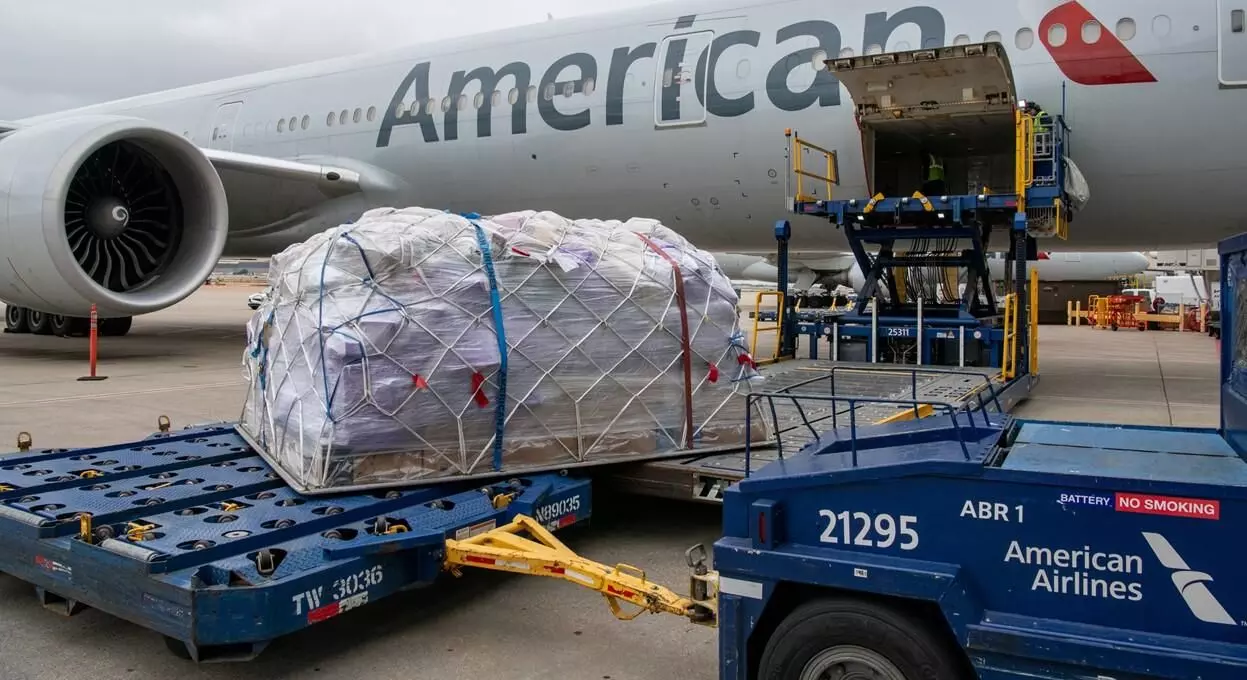Air cargo across the Americas is evolving rapidly, with North America experiencing a 7% increase and Latin America seeing an 11.7% rise. Meanwhile, U.S e-commerce is projected to reach $1.39 trillion by 2025.
The air cargo industry in the Americas has undergone significant transformations in recent years, shaped by global economic shifts, technological advancements, and changing consumer behaviour. From North America to South America, the air freight sector has demonstrated resilience and adaptability in the face of challenges while capitalising on emerging opportunities.
According to the latest data from the International Air Transport Association (IATA) for May 2024, North American carriers experienced an 8.7% year-on-year growth in air cargo demand in May, the weakest among all regions. Demand on the Asia-North America trade lane rose by 12.0% year-on-year, while the North America-Europe route saw an 8.9% increase, marking the highest demand growth for this route since mid-2022. May capacity increased by 2.5% year-on-year. Latin American carriers saw a 12.7% year-on-year growth in air cargo demand in May, with capacity increasing by 8.0% year-on-year.
“One of the most significant changes occurred in the years following the pandemic, when the demand for air freight services adjusted while the market experienced a consistent increase in airline capacity, mainly due to the resumption of international passenger routes with cargo capacity. This scenario was closer to a normal market with balanced demand and capacity, leading to a trend of lower prices compared to 2020,” says Diogo Elias, Senior Vice President at Avianca Cargo.
“At Avianca Cargo, we operate the medium-sized cargo fleet with the lowest environmental impact based in the region.”Diogo Elias, Avianca Cargo
“Conversely, in the last years in Latin America, we are witnessing the export of perishable products such as flowers, fish and fruits, which are experiencing a year-on-year growth, even today exceeding pre pandemic levels. In the southbound market, ecommerce, except from Asia, has sustained significant growth in recent years, leading to higher volumes and requiring fast delivery.”
One of the most prominent trends in the air cargo industry across the Americas has been the sustained growth in e-commerce-driven shipments. According to data published in Oberlo, a dropshipping app for Shopify, the U.S e-commerce forecast predicts growth to rise by 0.3 percentage points in 2025, reaching 10.8%, with online sales expected to hit $1.39 trillion. Another increase of 0.2 percentage points is projected for 2026, taking the annual growth rate to 11%.
“E-commerce continues to be one of fastest growing sectors within the industry and has fueled much of the industry growth we have seen in recent years – largely due to retail moving online and consumer expectations changing. We move a significant amount of e-commerce-related traffic across our network, particularly to and from Europe, from Asia–Pacific (APAC) to the U.S, and throughout our domestic U.S network. Forecasts suggest that this sector will continue to grow for the near future, and we are currently working to evaluate how our service offering will continue to evolve to meet the growing needs of this sector,” says Indy Bolina, Head of Global Sales, American Airlines Cargo.
“The Airforwarders Association (AfA) is proud to represent many members who are actively involved in the e-commerce boom. We see this sector as a major driver of growth in air cargo forwarding, and several of our members are participating in the U.S Customs & Border Protection’s Type 86 express clearance pilot programme. This programme offers faster clearance times for e-commerce shipments, which is crucial for meeting customer demand,” says Brandon Fried, Executive Director at Airforwarders Association.
The AfA is an association of U.S forwarders and a global alliance of indirect air carriers, cargo airlines, and affiliated businesses that advocate on behalf of its members.
Delta Cargo has recently announced the launch of its new product DeliverDirect, developed in collaboration with SmartKargo. DeliverDirect is a door-to-door delivery service for the U.S. market, offering a competitive and customisable solution for e-commerce retailers looking to optimise their direct-to-consumer shipping. The rise of e-commerce has not only boosted overall air cargo volumes but has also prompted airlines and freight forwarders to adapt their operations to meet the unique requirements of this segment.
Another significant trend is the increasing focus on sustainability and environmental responsibility within the air cargo sector. As concerns about climate change intensify, stakeholders across the industry are taking steps to reduce their carbon footprint and adopt more eco-friendly practices.
American Airlines Cargo has set ambitious milestones to achieve net zero emissions by 2050. The U.S carrier plans to replace 10% of its jet fuel with Sustainable Aviation Fuel (SAF) by 2030 and aims to reduce greenhouse gas (GHG) emissions intensity by 45% by 2035.

“At Avianca Cargo, we operate the medium-sized cargo fleet with the lowest environmental impact based in the region. Furthermore, we are committed to continuously seeking out and achieving our environmental targets and commitments, that is why we signed the CO2 connect agreement with IATA, to calculate the emissions generated by our operations,” says Diogo Elias of Avianca Cargo.
LATAM Cargo Brazil, one of the cargo subsidiaries of the LATAM group, will initially offset more than 5,000 tonnes of CO2 in partnership with Brix Cargo and Unicargo. These are the first cargo business clients in Brazil to join the 1+1: Offset to Conserve programme, which is aimed at offsetting flight emissions. LATAM Cargo has also been phasing out older Boeing 767-300 freighters in favour of more efficient Boeing 767-300ERs, resulting in reduced fuel consumption and emissions.

“Our global network is a huge advantage for us as a cargo carrier. In particular, our hub in Miami (MIA) is vital for us connecting freight across these regions.” Indy Bolina, American Airlines Cargo
The air cargo industry in the Americas has also witnessed a trend towards increased digitisation and automation. This shift has been driven by the need for greater efficiency, transparency, and real-time tracking capabilities.
“The Airforwarders Association recognises the importance of technology in the forwarding industry. We have a dedicated technology committee that works to identify and promote best practices in forwarding automation solutions. These efforts are helping our members stay up-to-date on the latest technologies and identify solutions that can improve their efficiency and competitiveness,” says Brandon Fried of Airforwarders Association.
“We are intently focused on delivering digital innovation and operational excellence through the remainder of this year. We are continuing to invest in digital transformation, which enhances the customer experience and improves operational efficiency. These investments are possible thanks to the recent upgrade of our end-to-end cargo management system that was initially implemented in 2019 and marked the beginning of our digital transformation. Having a modernised platform provides us with a foundation to build upon, which is the phase we are in right now,” says Indy Bolina of American Airlines Cargo.
“That includes direct connection capabilities with customers, implementing the use of modern tools like automation and machine learning, and expanding self-serve capabilities for our customers on our aacargo.com channel. Part of our digital innovation strategy also includes expanding our distribution channels through enabling third-party offerings including CargoAI, with whom we recently announced a partnership.”
“We are the first cargo airline to connect simultaneously with the three marketplaces, CargoAI, cargo.one and WebCargo. Also, we became the first cargo airline in South America to have an integrated system with DB Schenker. We use Airblox, an online marketplace that allows us and the freight forwarders to exchange cargo capacity in the form of electronic block space agreements (eBSA) and the published offer is for two months with more than 280 flights available,” says Diogo Elias of Avianca Cargo.

“Technology is the engine powering efficiency in the air cargo and freight forwarding industry.” Brandon Fried, Airforwarders Association
WestJet Cargo has also teamed up with cargo.one to launch the airline’s capacity on the air freight platform. cargo.one is applying its digital sales expertise to help WestJet Cargo broaden its footprint and optimise market-fit for all its markets.
While Air Canada Cargo has chosen Rotate to implement the Sales Cockpit, The Sales Cockpit is a sophisticated web-based software that continuously scans the airline’s data to automatically identify specific opportunities with customers.
Despite positive trends in the American air cargo industry, significant challenges persist. One of the most pressing issues is infrastructure constraints at major airports. As freight volumes increase, key hubs are grappling with congestion and limited capacity. Efforts to alleviate these challenges include the recent inauguration by United Cargo of a new state-of-the-art, 165,000-square-foot cargo facility at Newark Liberty International Airport (EWR). This airport is crucial to United’s cargo operations, accounting for nearly 30% of its global tonnage and revenue. Furthermore, there are upcoming plans to enhance cargo capacity at Miami International Airport, the primary international airport in South Florida. The airport serves cargo flights to cities across America, Asia, Africa, and Europe.
The air cargo landscape in the Americas is characterised by diverse product flows. Diogo Elias of Avianca Cargo says “The main products transported on Northbound are flowers, which account for 65%, and fruit, which accounts for 28%. On the Southbound side we have luxury brands, pharmaceuticals, and general cargo.” This highlights the importance of perishables in north-south trade within the Americas.
However, these established trade patterns are likely to see shifts in the coming years. The increasing focus on resilience and diversification in global supply chains is expected to impact air cargo flows across the Americas. As companies seek to reduce their reliance on single sources of supply, new trade patterns may emerge, potentially benefiting air cargo routes connecting the Americas with other regions.
Airlines are already preparing for this evolving landscape by expanding their networks and connections. Elias notes, “In terms of our network to Europe as a strategic hub for connecting to other markets, in the July 2024 season we will have 39 frequencies with an estimated capacity of 1,100 tonnes per week (round trip) and through our interline agreements we will connect more than 80 countries around the world to strategic commercial destinations including Africa and Asia.”
This approach not only serves current demand but also positions Avianca Cargo to capitalise on emerging trade patterns as supply chains diversify.
American Airlines Cargo also emphasises the importance of strategic hubs in facilitating regional and global connections. Indy Bolina of American Airlines Cargo, highlights their network advantage “Our global network is a huge advantage for us as a cargo carrier. In particular, our hub in Miami (MIA) is vital for us connecting freight across these regions. American operates multiple daily departures out of MIA to key cities in Central and South America, which provides flexibility for shippers and ensures freight can be transported quickly and reliably wherever it needs to go.”
The air cargo industry in the Americas is increasingly characterised by greater regional integration and collaboration. Cargo carriers across the continent are forging partnerships with each other.
Delta and LATAM Cargo have recently celebrated their partnership. Delta Cargo’s partnership with LATAM Cargo provides access to more than 300 destinations spanning the US, Canada, and South America, encompassing Brazil, Chile, Colombia, Ecuador, Paraguay, Peru, and Uruguay. Co-located cargo facilities, such as those in Atlanta (ATL), Sao Paulo (GRU), and Rio de Janeiro (GIG).
“We will be announcing the reinforcement of our west coast network that is part of our plan to strengthen cargo hubs in the USA and bolster operations in Mexico by adding value with a more integrated network between Avianca Cargo and our Mexican commercial partner airline, AeroUnion. This announcement includes the arrival of the new P2F that will join AeroUnion fleet in accordance with our integrated network and fleet expansion strategy aimed at delivering value to the customers on the west coast,” says Diogo Elias of Avianca Cargo.
As air cargo giants forge new partnerships and expand routes, the industry’s landscape is shifting. From Miami to São Paulo, carriers are betting big on e-commerce, sustainability, and digital solutions. With supply chains in flux, the race is on to capture emerging markets and meet evolving shipper demands. The skies over the Americas are set for an exciting, transformative journey ahead.





















